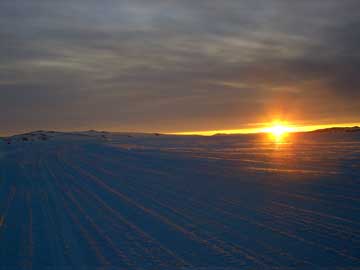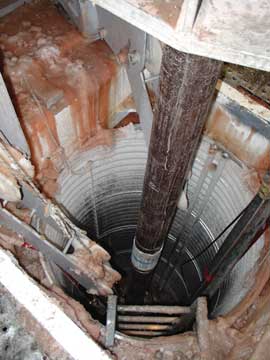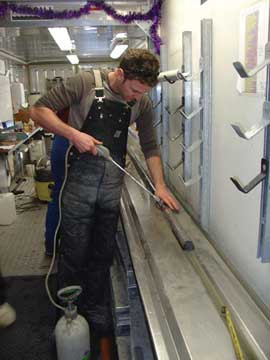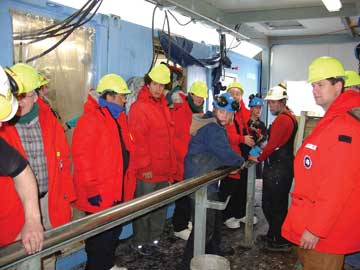|
FEATURE
Examining Antarctica
Tim Naish, Ross Powell, Rich Levy and the ANDRILL-MIS Science Team
 Photos courtesy of Ross Powell |
| Sunrise at 2:30 a.m. on the road over the McMurdo Ice Shelf going out to the ANDRILL drilling rig. |
During the Southern Hemisphere’s last summer, between October 29 and December 26, about 80 researchers, drillers, educators and support staff from four nations met in Antarctica to drill deeper than ever before into the Antarctic continental margin. With a recovery rate of 98 percent, the new core represents the longest and most complete geological record from the seafloor just off Antarctica. Researchers working on the project hope the core will help them understand Antarctica’s storied past.
The core is the first drilling project of the ANDRILL Program (ANtarctic geological DRILLing), a multinational cooperative program with members from the United States, New Zealand, Italy and Germany that aims to recover long geological records to decipher Antarctica’s climatic, glacial and tectonic history over the past 50 million years (see Geotimes, March 2006). Because most of the continent is covered by ice more than three kilometers thick, the record of Cenozoic-aged rocks exposed on land is limited and fragmentary. Thus, to date, drill cores from both land and offshore have contributed to our understanding of Antarctica’s climate and ice sheet history. That understanding has been largely derived from remote lower-latitude data, such as deep-sea oxygen isotope and continental margin sea-level records. Although very helpful, the geological drill cores previously recovered from Antarctica are few and the total record is fragmentary. ANDRILL aims to extend and fill in the gaps in the present database through continued geological drilling from sea ice and ice shelf platforms around the Antarctic margin.
ANDRILL was motivated by our lack of knowledge of the complex role the Antarctic cryosphere (ice sheets, ice shelves and sea ice) plays in the global climate system. Understanding the history of how ice volumes varied over time and the associated physical changes in the Antarctic region is critical for assessing the interaction of ice sheets with other elements of the earth system, such as oceans, the atmosphere, lithosphere and biosphere.
Drilling the Margin
Last year’s McMurdo Ice Shelf Project was situated in the Windless Bight region of the McMurdo Ice Shelf, about 11 kilometers east of Scott Base and McMurdo Station and located within the Victoria Land Basin, a tectonic extensional rift basin offshore from the Transantarctic Mountains in the western Ross Sea. We recovered a single 1284.87-meter-long drill core from below the seafloor. It was not an easy task. By melting the ice around the drill pipe, we drilled first through 85 meters of floating ice shelf and then through another 850 meters of seawater that filled a deep crustal moat created by the weight of the active Mount Erebus and other volcanoes that comprise the nearby Ross Island.
 Photos courtesy of Ross Powell |
| Drilling the core was quite a process, drilling through 85 meters of floating ice shelf and then lowering the pipe through another 850 meters of seawater, while all the time melting ice around the drill pipe going through the ice shelf. Here the outermost pipe or “riser” is seen going down a well that was melted in the top of the ice shelf. |
We employed a sea-riser system, in which an outer pipe structure around the deployed drill pipe helps regulate pressures during drilling. The riser system is cemented into the seafloor and held at the rig platform by a system designed to compensate for the tidal rise and fall of the ice shelf. Coring systems included a combination of soft-sediment coring tools in upper sediments and continuous wireline diamond-bit coring in deeper rocks, which is designed to recover as much of the core as possible with minimal disturbance and contamination. Furthermore, innovative new technology — in the form of a hot-water drill and “over-reamer” — was used to make the access hole through the ice shelf and to keep the riser from freezing to the ice shelf during drilling operations.
Understanding the System
The behavior of Antarctic ice sheets in response to projected warming scenarios for the rest of this century and beyond remains uncertain, which has consequent uncertainties on rates and amounts of future sea-level rise. Understanding the role of how Antarctic ice may drive global climate variability requires a fundamental knowledge of Antarctic cryospheric evolution, not only in recent times, but also for earlier periods when global temperature and atmospheric carbon dioxide concentrations were similar to levels that might be reached by the end of this century. Key to achieving this will be using a combination of numerical global climate and dynamic ice sheet models and geological data from when Earth is known to have been warmer than today, such as during warm “super-interglacial” periods that occurred in both the Early Pliocene (around 4 million years ago) and parts of the Quaternary (for example, around 1 million years ago). During these past “super-interglacial” warm extremes, the marine-based West Antarctic Ice Sheet and its fringing ice shelves apparently collapsed and global sea level was more than five meters higher than today.
Preliminary Findings
The drill core includes a succession of cyclic glacial and glacimarine sediment with interbedded volcanic deposits that provide a key reference record of climate and ice sheet variability through the Late Neogene (about the last 14 million years). We gained a significant new understanding about the ice sheet history and paleoenvironmental changes the Antarctic has experienced over the past 14 million years during the drilling season and have some noteworthy initial results, but the potential of the record for improving our knowledge of Antarctica’s influence on global climate and vice versa is even more exciting.
 |
| Researchers recovered a 1284.87-meter-long drill core that recorded Antarctica’s history over the past 14 million years. Above: A science technician washes drilling mud off the outside of the core before it is described, analyzed and sampled. Below: Members of the National Science Board (red coats) and Tom Wagner (right), the Program Manager from the National Science Foundation, which helped fund the project, are waiting expectantly to see a new length of core be extracted from the core barrel by ANDRILL drillers. |
 Photos courtesy of Ross Powell |
The core contains a range of rock types, including glacial and volcanic diamictites (sediments with a very wide range of particle sizes, including glacial till), sandstones and mudstones; sediments made up almost entirely of silica fragments of diatoms, marine algae called diatomites; and volcanic ash/tuff and one lava flow. We have identified 11 distinct sediment types, ranging from open marine diatomites and mudstones, some with stones dropped from icebergs floating above, to sediment flow deposits coming from the ice sheet as it sat on the seafloor, to deposits from streams issuing across the seafloor from the base of the ice sheet, to till, the characteristic sediment deposited under the ice sheet. These different sediments vary down the core going back through time and reflect periods of the ice sheet growing and gradually advancing over the site and then retreating again to allow the open marine conditions to return. More than 60 of these cycles are present in the core spanning the last 14 million years. They reflect the response of the ice sheet to major global warming and cooling events driven by variations in Earth’s orbit, called Milankovitch cycles. Because these past warming and cooling events were not the same, we hope we can test the sensitivity of the ice sheet to different levels of warming and associated atmospheric carbon dioxide levels, that may provide some sense as to how it may behave in the future.
In addition, we recognize that these cycles are made from three types of sediment groups, or motifs, that appear to represent periods of distinct climate and ice sheet regimes through time. The first motif is represented by tills separated by thin interglacial mudstones indicative of ice shelf to marginally marine conditions very similar to the present interglacial. This motif represents the cold polar climate and ice in the Late Miocene, about 13 million to 10 million years ago, and the Pleistocene, about 1 million years ago to present.
The second motif begins with a basal till and grades upward through ice sheet retreat to more distal glacimarine deposits and finally into open-water diatomites. It represents a relatively warmer climate, with polythermal ice sheets and interglacials during the Pliocene, about 5 million to 2 million years ago. An approximately 90-meter-thick Early Pliocene interval of diatomite within this motif shows no apparent glacial cyclicity and represents an extended period of ice-free conditions indicative of a reduced West Antarctic Ice Sheet. Spectacular cycles during the Late Pliocene, about 2.6 million to 2.2 million years ago, of this type imply significant ice sheet changes, and contribution to global ice volume changes coeval with the initiation of Northern Hemisphere glaciations.
The third motif is similar to the second, except that diatomite is absent and the upper portion of the cycle is dominated by mudstones, implying that the water was too turbid from the glacial streams to allow the diatoms to flourish and dominate as they did in apparently cleaner waters of the Pliocene. It represents a warmer climate and polythermal glacial ice, perhaps similar to warmer parts of Greenland and Svalbard today, with interglacials dominated by mudstones originating from meltwater streams coming from the base of the ice sheet during the Early to Late Miocene, about 9 million to 6 million years ago.
This core record has the potential to contribute significant new knowledge on the dynamics of the West Antarctic Ice Sheet and Ross Ice Shelf/Sheet system. Our environmental reconstructions to date imply changes in ice sheet volume that must have contributed significantly to global sea levels and ocean circulation in the past. We can infer that the same may be true in the future. With this potential of a much stronger understanding of Antarctica’s past environmental changes relative to the rest of the world, and how the ice sheet responded to those changes, we truly hope to gain clearer insight into what might be in store. Stay tuned for new scientific results from our team’s research on the core, which should be coming soon.
Links:
"Drilling Back to the Future," Geotimes, March 2006

 Subscribe
Subscribe


